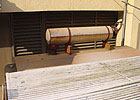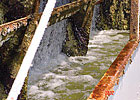
Humidification, air intake location, and cooling tower operation - these three components continue to require vigilance in preventingLegionellafrom cropping up. Smart choices, from design through ongoing maintenance, can prevent problems and protect health.
Legionnaires’ disease is costly. Building owners, or their insurers, pay big legal bills defending lawsuits brought by people who claim to have become ill from exposure to a water system that harboredLegionellabacteria, or by the families of those who die from the disease. Some businesses pay even more in lost business due to bad press and word of mouth. But the highest price is paid by the people who get sick, some suffering long term or even dying from the disease.
More than 95% of the Legionnaires’ cases that are contracted at hotels or other public places (not including hospitals) go undetected, and only a sliver of the 5% that are detected are reported by the press. Public perception, therefore, is that the disease is rare, when in fact 8,000 to 18,000 cases occur each year in the United States, according to the Centers for Disease Control and Prevention (CDC) in Atlanta. As public awareness increases and diagnostic technology improves, a much higher percentage of cases will likely be diagnosed and reported.
Legionnaires’ disease is contracted by exposure to water contaminated withLegionellabacteria. People can be exposed toLegionellawhile using a bathroom faucet, showering, bathing in a whirlpool spa, walking by a water feature, or drinking from a water fountain. Also,Legionella-contaminated water mist can drift from cooling towers to building occupants through fresh air intakes or windows, or directly to individuals who are outdoors. The bacteria can be inhaled into the lungs in small airborne water droplets, or aspirated (choked) into the lungs while drinking. To reduce health and legal risk, facility managers should take steps to minimizeLegionellabacteria in plumbing systems, whirlpool spas, water features, cooling towers, and other water systems.
About 20 countries have guidelines for reducing the risk of Legionnaires’ disease. In Australia and the United Kingdom, violations that result in disease can carry stiff penalties and even prison terms. Although guidelines in the U.S. are generally not as thorough and are not mandated, several U.S. government agencies and industry groups advocate a proactive approach to minimizeLegionellabacteria in water systems, including the EPA, the Occupational Safety and Health Administration (OSHA), ASTM International, and ASHRAE.
The guidelines do not agree on every detail, but virtually all of them recommend preventive measures to minimizeLegionellabacteria in water systems. The prevention program should start with an expert assessment of plumbing systems, cooling towers, and other water systems to identify conditions that promote growth or transmission ofLegionellabacteria. The next step is to write a waterborne pathogens management plan that outlines specific risk reduction measures (based on the assessment findings) and policies and procedures for maintenance and operation of water systems. Education is especially important, so that employees and contractors routinely involved with the water systems know how to identify and correct conditions conducive to contamination. Routine water testing forLegionellashould be done to check the effectiveness of the preventive program, and appropriate remediation implemented based on the test results.
Air Distribution Systems
Air distribution systems can serve as a breeding ground and pathway forLegionellabacteria. The eight preventive measures that follow, some of which have been widely recommended for overall IAQ, will reduceLegionellarisk.- Avoid cold-water humidifiers in ducts. If humidification is required, use steam humidifiers instead. Steam units are generally not conducive to Legionella because they operate at a temperature above which the bacteria can survive. In addition, they generate vapor rather than water droplets.
If cold-water humidifiers cannot be eliminated, provide them with a domestic water source and drain line instead of using recirculated water. The supply water should ideally be at 68°F (20°C) or below.
Keep all humidifiers leak-free and clean.
- Keep ducts dry. Design ducts so that water from condensation or other sources does not accumulate. Drain lines should include a trap and air break so that contaminated water is not drawn back into the system.
In the vicinity of humidifier installations, check ductwork periodically for evidence of condensate pooling. In some cases, moisture from humidifiers pools downstream in the duct.
- Make sure that condensate drain pans drain well and are kept clean. Clean the pans with a biocide at least twice a year - preferably once a quarter - to remove all slime and dirt (little should accumulate if the pans drain properly). Replace drain pans that are significantly rusted.
- Keep all coils leak-free. The chilled and heating water systems are theoretically closed loops, but if coil leaks occur, contaminated water will spray directly into the ducts and could enter rooms via the airstream.
- Ensure that air filters are dry. Wet filters provide a habitat for bacteria. In addition, airborne water droplets can be distributed to occupied spaces. Air filters should be cleaned and replaced as recommended by the manufacturer.
- Locate cooling towers far from outdoor air intakes. A minimum of 33 ft (10 meters) has been suggested, but at least 100 ft (33 meters) is much safer. Cooling towers should also be located as far as reasonably possible from operable windows, parking lots, roads and driveways, sidewalks, and outdoor areas frequented by people. Also, make cooling towers inaccessible to visitors and passers-by (e.g., with a fence or wall). In hospitals, patient windows should be kept closed.
- Control Legionella in cooling towers. Covering all the recommended Legionella control measures for cooling towers would take another article, at least. Let’s proceed with a brief synopsis.

Cooling Towers = Potential Hotspots
Treat cooling towers for control of scale, corrosion, and microbes including protozoa andLegionella. Be sure that the water treatment service agrees with these objectives. The water treatment company should not be expected to guarantee zeroLegionellabacteria, but should agree that control ofLegionellaand other microbes is an objective of the treatment program.Each situation is different, so the water treatment company or other water treatment expert who is familiar with the cooling tower should determine the details of the treatment program. However, be sure to consider the guidelines issued by the Cooling Technology Institute (Legionellosis Guideline: Best Practices for Control ofLegionella,www.cti.org), OSHA, and the Association of Water Technologies (www.awt.org), particularly regarding the combination of oxidizing and nonoxidizing biocides. Follow ASHRAE Guideline 12-2000 regarding cooling tower shutdown and startup.
IfLegionellabacteria counts are above the target level, consider using side stream filtration to reduce suspended solids and the demand on the biocide. In most cases, filtering 3% to 5% of the circulated water to 10 to 15 microns is sufficient. A filter vendor can recommend a media based on a particle size analysis.
Physically clean cooling towers at proper intervals. Studies indicate that cleaning alone has little effect onLegionellabacteria concentrations but is crucial for effective water treatment. Deposits become sites for bacteria and corrosion. A buildup of algae, fungi, protozoa, dirt, and biofilm puts a greater demand on a biocide and may prevent a biocide from making contact with microorganisms.
The cleaning frequency will vary from tower to tower and depend on operating conditions and the effectiveness of the water treatment program. Clean basins monthly or more often if significant buildup of deposits occurs between cleanings. Ideally, the entire cooling tower system should be drained and flushed and all surfaces thoroughly cleaned two to four times a year. More frequent cleanings may be necessary if there is heavy scale deposition or excessive solids entering the system (e.g. if the tower is near a dusty construction site). A professional cooling tower cleaning service should determine the appropriate procedure for a given tower.
Avoid conditions that promoteLegionellagrowth in cooling towers. For example, remove dead legs (infrequently used piping with stagnant water) from the system. A significant volume of water may be contained in the piping that circulates water between the cooling tower and chiller. Biocides will not likely be effective in stagnant areas or dead legs. Keep pipe lengths as short as possible (e.g., to and from the heat exchanger) and the number of fittings to a minimum to minimize biofilm within piping. Biofilms are whereLegionellabacteria flourish within cooling towers; the loosening of biofilm has been associated with outbreaks of Legionnaires’ disease. Shield the cold-water basin and other wet surfaces from sunlight to prevent algae growth. And keep kitchen exhaust, overhanging tree limbs, plants, and other sources of living organisms away from cooling towers.
Check the cooling water regularly - preferably daily but at least twice weekly - for pH, total dissolved solids, disinfectant levels (if applicable), and other parameters required for evaluating the water treatment regimen. At least two times a week, test the total bacteria count (TBC) or Adenosine Triphosphate (ATP) level to evaluate the water treatment - a significant rise indicates a problem (e.g., a broken chemical pump). However, do not assume that a cooling tower isLegionella-safe just because the TBC is low. There is no reliable correlation between TBC andLegionellabacteria.
For a load of less than 150 tons, consider alternatives to small cooling towers. Otherwise, be sure to monitor the water treatment program of small towers closely, and checkLegionellalevels regularly. IfLegionellaare not under control, even after changes in the treatment regimen, the small tower should be replaced with an air cooled unit, or its load shifted to another cooling tower. Small cooling towers have been implicated in numerous outbreaks of Legionnaires’ disease. This could be due to difficulty in treating water that is turned over frequently, but more likely is because small cooling towers do not get the maintenance attention that large ones do.
Install and maintain high-efficiency drift eliminators. Consider replacing drift eliminators on older towers with new higher-efficiency models. Replace deteriorated eliminators. However, do not rely on high-efficiency drift eliminators to give total protection against transmission ofLegionellabacteria. Some small droplets (smaller than 5 microns) will likely escape even the best eliminators.
Legionellaprevention is smart. Spending a modest amount of money on preventive measures yields a significant reduction in health and legal risk, and it may even save a life.ES

 Freije is president of HC Information Resources Inc. (Carlsbad, CA,
Freije is president of HC Information Resources Inc. (Carlsbad, CA,